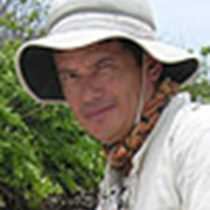Western of Isabela Island
Our day of exploring the youngest part of the Galápagos archipelago began in the shadows of Alcedo and Darwin volcanoes. They are colossal and were covered in green, which contrasts with Fernandina Island behind us, the island we visited yesterday. We anchored in Urbina Bay. This is a well-known place due to a geological event in 1954. More than a square kilometer of sea floor was uplifted approximately four meters in a short amount of time, leaving the sea bed exposed with many marine species stranded high and dry.
At the landing beach our guests could disembark easily from the Zodiacs for a short hike to the uplifted area. This is a surrealist place surrounded by fossilized creatures, mute witnesses of that event that occurred years ago, when the ocean literally boiled all marine life in few seconds. Just a few meters from the beach we saw a giant tortoise walking slowly along the trail as if looking for a shady place, because the sun was warming considerably its dark carapace. We observed many land iguanas’ burrows and many different species of trees with yellow flowers trying to catch the attention of carpenter bees, which accomplish a very important role pollinating them. Continuing our walk inland, we observed many land iguanas resting along the trail; many males and females, all of them adults exhibiting their gorgeous yellow colors indifferently while regulated their temperature.
Near the end of the hike we observed a steep area with what looked like an iguana burrow, but there was dust coming out of it. Curiously we approached to investigate and to our surprise we found a baby giant tortoise inside instead of an iguana.
In the afternoon we dropped anchor in Tagus Cove, a famous place well-known by pirates during the 17th and 16th centuries, a perfect place to hide or dry dock their ships. Our guests were given the options of kayaking, deep water snorkeling and hiking along the Darwin Lake. I went to snorkel with a group, and we observed more than 28 sea turtles swimming around us, Galápagos penguins feeding anxiously on small salemas, and on the surface we saw pelicans catching bigger fish. It was an excellent snorkeling outing.
After snorkeling we went to explore an old cinder cone. In its interior we saw Darwin Lake, and it looked majestic with an orange color reflecting the last beams of light of the day. Along the trail we observed land birds such as finches and mockingbirds fluttering over our heads. Finally we arrived at what would have been the beginning of the lava flow. This eruption destroyed the island’s life, and left a remarkable difference in between the black lava and the green vegetation. We could imagine how nature forms new landscapes.
It was late, after the sunset, when we headed back to National Geographic Islander, our home during this marvelous week.




